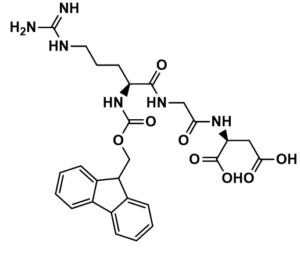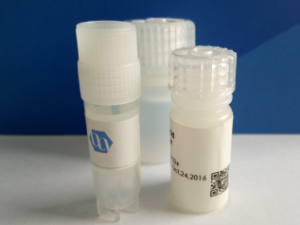$ 300.0
Quantity: 50 MG
In stock (can be backordered)
Description

Product name: Fmoc-RGD
Catalog#: 1502022
Synonyms: Fmoc-Arg-Gly-Asp
CAS NO.:
Sequence: Fmoc-Arg-Gly-Asp
Modifications: N-terminal Fmoc,
M.W: 568.58
M.F.: C27H32N6O8
Purity: 98% by HPLC
Counter ion: Trifluoacetate
Format: Lyophilized powder
Description: Fluorenylmethoxycarbonyl-diphenylalanine (Fmoc-FF) and fluorenylmethoxycarbonyl arginine–glycine–aspartic acid (Fmoc-RDG) form hydrogels based on aromatic interactions and have been successful as a scaffold for cell culture. The hydrogel is a relatively simple gelator relying on a few peptides and Fmoc groups and is formed by pi–pi staking between the Fmoc groups, thereby forming 3 nm fibrils which interact laterally to create “flat ribbons.” RGD groups were added to increase cell attachment (Figure (Figure2,2, in red) and these gels produce a viable 3D encapsulated cell culture with HDFa cells. As such, the scaffolds are suitable for assessment by various methods including fluorescence microscopy and the MTS assay. The cell gel constructs are formed by dissolving the peptide in DMSO followed by dilution in an aqueous solution at pH 10 (Fmoc-FF) or pH 3 (Fmoc-RGD), followed by adjustment of the pH to physiological conditions. The solutions can then be mixed with cells in culture medium. The gel forms quickly <1 min and has a G′ of around 780 Pa with the final stiffness of the gel being primarily dependent on the final pH. Within this system, addition of amino acids other than RGD were tested as well resulting in hydrogel constructs that were more suitable for some cell lines than others.
Compound ID:
Usage: For Scientific Research Use Only, Not for Human Use.

